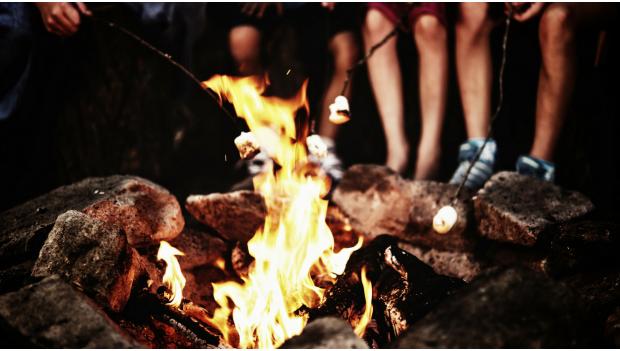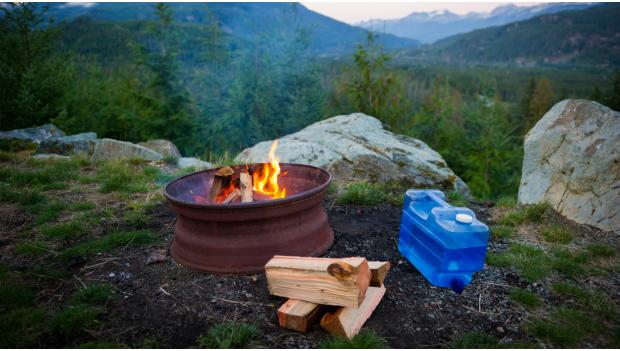
Enjoying the pop and hiss of a glowing campfire—not to mention the light and warmth that the fire provides—is one of the most enjoyable parts of camping. But building campfires comes with responsibility. A campfire that is not properly built, maintained, and extinguished can quickly become a hazard to the people, animals, and land around it. In the United States, people start nearly nine out of 10 wildfires. It’s important to understand how to safely and responsibly enjoy your campfire.
These are the top 10 must-know tips for campfire safety.
1. Know the rules
Before you strike a match, make sure you know the fire regulations of the campground or wilderness area in which you are planning to build a fire. Fire rules change, and a campground that allowed campfires the last time you visited my have a temporary ban on them if the risk of wildfires is high. Pay attention to posted signs and check the ranger’s station for current campfire regulations.
2. Use the pit
Most campgrounds provide a fire pit or fire ring in which to build a campfire. If a pit is provided, this is the only place you should build a campfire. If you’re in a remote area where campfires are allowed but a pit is not provided, dig a fire pit in an open area away from overhanging branches, power lines or other hazards that could catch on fire. Once the pit has been dug, circle the pit with rocks, ensuring there is a ten-foot area around the pit that is cleared of anything that could catch on fire.
3. Build a safe campfire
Once your pit is in place, build a safe campfire. Start the fire with dried leaves or grass that will easily catch fire. Next, add kindling, small twigs and sticks that are less than an inch in diameter. As the fire builds, add the largest pieces of wood to the fire. They will keep the fire burning for a longer period of time and provide heat. Keep in mind that your fire does not have to be roaring. A small fire surrounded by rocks will produce plenty of heat for both cooking and warmth.

Also Read: 5 Easy Grill Recipes Anyone Can Master
4. Mind the match
Start your campfire with a match and then make sure it is completely extinguished before disposing of it. Pour water over the match or throw it directly into the fire to burn. Never use lighter fluid, gas, kerosene, or other flammable liquids to start a fire.
5. Use local firewood
Though it may not be apparent to the naked eye, tree-killing insects and diseases can live on firewood. If you’re going camping six hours down the road and decide to bring firewood from home you could, without knowing it, transport insects and diseases and inadvertently introduce them into the forests where they weren’t found before. That’s why it’s so important to use local firewood. Local is defined as the closest convenient source of firewood that you can find. If possible, pick up firewood from the campground camp store or a nearby location.
6. Keep water handy
Don’t start a campfire without having a bucket of water and a shovel nearby. The water can be used to douse any runaway flames and the shovel can be used to throw sand or dirt on any flames that jump the perimeter of your fire ring. It’s also smart practice to keep a few feet of ground outside of your fire ring watered down, so if a stray ember or flame jumps outside of your fire pit, it won’t gain any traction.

Also Read: Great Places to Find Water Trails
7. Pay attention to the wind
A strong breeze can spread your fire in an instant. To make sure a sudden gust of wind doesn’t turn your campfire into a wildfire, keep anything flammable, including unused firewood, upwind and at least 15 feet away from the fire. The 15-foot rule also goes for your tent and clothing hung to dry.
8. Be careful with kids and pets
It’s not just the risk of forest fires that you need to be mindful of while camping. Campfires are the leading cause of children’s camping injuries in the United States. Teach your kids about the danger of fire and don’t allow children or pets around the campfire unless they are on an adult’s lap. Teach kids how to stop, drop, and roll in the event that their clothes catch on fire.
9. Never leave a campfire unattended
A campfire should not be left alone, even for one minute. A small breeze can spread fire quickly, so there should be at least one set of eyes monitoring the fire at all times. Even if you’re leaving the fire for a short period of time, like to take a quick hike, the fire should be completely extinguished. You’ll be able to restart it once you return.
10. Put the fire out properly—every time
When you are done with your campfire make sure it is extinguished properly. Dump water on the fire, stir the ashes with a shovel, then dump more water on the fire. The campfire should be cold before you leave it unattended. If it is too hot to touch, then it is too hot to leave. Large logs will be more difficult to extinguish than smaller logs so make sure they are also soaked with water. Move the stones around the campfire to check for hidden burning embers underneath. And never bury coals from the fire—they can smolder and start to burn again.
Are you ready for an outdoor adventure? Plan your camping trip.
Check with your Local Government Organization
Many policies have been established to counter and control the coronavirus outbreak. State and local officials have been taking decisive action to stop the spread. The policies vary by state, sometimes to a great degree. When you book a reservation, make sure to review the park and state’s latest rules and regulations prior to your visit.
For COVID-19 updates, please visit our Impacted Park List and Reservation Guide for the latest information.